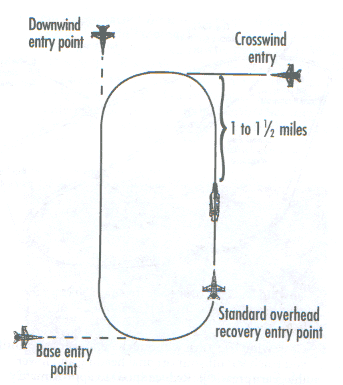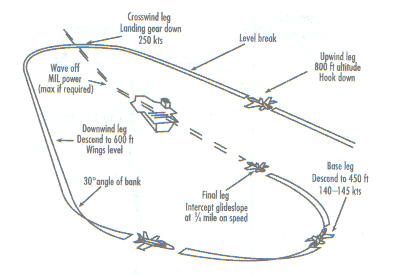
56th Training
Course
Page navigation
1-2-3
Lag
pursuit | Combat Spread | Engaging
Turns | Carrier Landings | Offensive
& Defensive | Wingmen Techniques
Carrier Landings
Welcome aboard the USS CVN-65 Enterprise, This tutorial will help you on the carrier operations, assuming you know how to control de F/A-18 Hornet at low speeds and low altitude parameters, including how to read the HUD symbology, ILS and LSO instructions. You can use this manual to practice carrier landings in network games.
2.0. - Landing Procedure stages.
There are two types to enter the pattern: In formation or waiting on the marshal area, the last one is located about 10+ miles astern and 5000 feet MSL.
2.1. - IFR Pattern or Marshall Area.
Use this configuration during bad weather or in emergency landings. As Wing leader you will always make your approach first, leaving your wingman(s) at the marshal point to land after you in order of Wing formation.
The next step is to configure your F/A-18 in the approach pattern, selecting the ship TACAN and flying toward it. Slow down your speed to 250 Knots and descend to 1200 feet MSL, drop down the gear and hook, slowing down your aircraft to approach speed (AOA) and reset the HUD to Navigation mode and ask to control tower to land clearance. Finally you came to the stage called "Shooting your Approach" this is when you begin your final descend to the deck, at ¾ miles you have the option of transitioning to a visual scan following the ball or call for the LSO assistance, follow the Instrument Landing system (ILS) beam and the LSO instructions.
2.2. - In Formation.
This one is the most useful system on carrier operations. For this one you and your Wingman(s) fly in echelon or line astern formation approaching the carrier using different entry forms, Call the Carrier Air Traffic Control Center (Ctrl + T) they’re going to tell you the way to enter to the carrier pattern. Fly around the carrier at 250 knots and 800 feet MSL and jettison your remaining weapons, as leader you are the first one to enter into the final approach. The next plane to land is the Wingman # 1, when the leader takes the approach pattern, the next plane start the VFR pattern, if everything is correct every plane goes to touchdown every 45 seconds.
2.3. - VFR Pattern.
Upwind leg: Pass over the carrier at 250 knots, drop down the hook (H), check your heading and turn left at 20 to 30 degrees at 1 to 1½ miles from carrier’s bow.
Crosswind leg: Turn without changing altitude until you reach 90 degrees of your original heading, lower the gear and reduce speed to approximately 180-200 knots.
Downwind leg: Continue your turn until your heading is exactly opposite of what it was on the approach. Descend to 600 ft MSL. As you approach the end of the downwind leg, the air traffic control will inform you that you’re clear to land, do not turn onto the final leg until you receive this call. This message doesn’t mean that is time to turn, it just means you’re being handed off to the LSO for final approach instructions.
Final or Base leg: When you’re about ¾ to 1 mile beyond the stern of the carrier, bank left again at the same angle you did the first time. As you turn onto the final leg, descend to 450 feet and slow down to 140-145 knots, call the LSO (Ctrl + L) and follow his instructions into final touchdown.

Final approach: Continue turning, taking care to line up with the landing deck. You should now be about a mile from the carrier, flying at 140-145 ft, when the LSO call you to "Roger ball" you’ll check your landing status, Gear is down, tailhook is down and you can see the meatball. Continue lined up with the carrier landing deck, remember the landing deck is offset 10 degrees to port the carrier centerline. If you are within landing parameters, you should be receiving instructions from the LSO, follow his instructions he is your best friend while you’re landing at the carrier, he can see your trends well before you do.
If you get "bolter" or the order "Wave off" abort the landing! Apply military full power, keep your landing gear down until you get back up to 200 knots and go around again for another attempt, it is now safe to bank left 180 degrees. Retake downwind leg and try another approach.
In real carrier operations the planes have 3 opportunities to catch the wires, if not they join the flying planes around the carrier and the next one in formation goes to make his approach, the planes who doesn’t land on his 3 chances goes to the final in line to land.

3.0. - LSO Qualifications.
After a successful landing the LSO will grade your landing pass:
Perfect pass: You maintained an optimum glideslope and line up thought the landing approach, 4 points.
Good landing pass: You had minor deviations in the landing approach, but made good corrections, 3 points.
Fair pass: You had minor deviations in the landing approach, 2 points.
No grade: your approach was below average (for example you dropped your hook or lowered your gear late), but you landed safely, 1 point.
Unsafe: There were gross deviations in your landing approach inside of 2000 feet and/or ignored the wave off call, 0 points.
Once you touchdown move fast out of the landing deck, another plane is only 45 seconds behind you.
4.0. - Landing practice.
You can practice your landings using the
"touch & go" procedure, follow all normal landing procedures
except don’t lower the hook, it’s a good technique to land.
Attempt to shorten your flight back to the ILS entry point, by turning back into
the pattern only 1 or 2 miles back from the carrier. This will reduce fuel
consumption and time aloft, which may mean the difference between getting home
or running out of fuel. You should do this at lower altitude as well (1000 ft.
Or less) since you’ll be intercepting the ILS closer and lower to the ship.
Also you can use the "Carrier Operations" mission on the Hawaiian
Practice area to practice, the escort ships behind the Enterprise can be a
visual reference to turn into the final leg, try to turn over them and catch the
ILS entry point. If you follow all this instructions and advises you can land
your planes every 45 seconds.